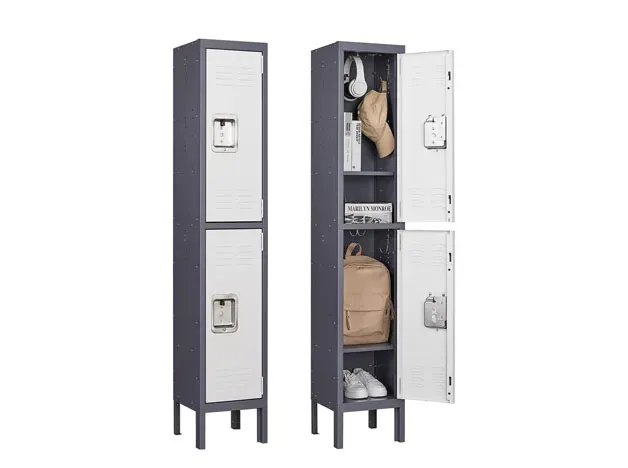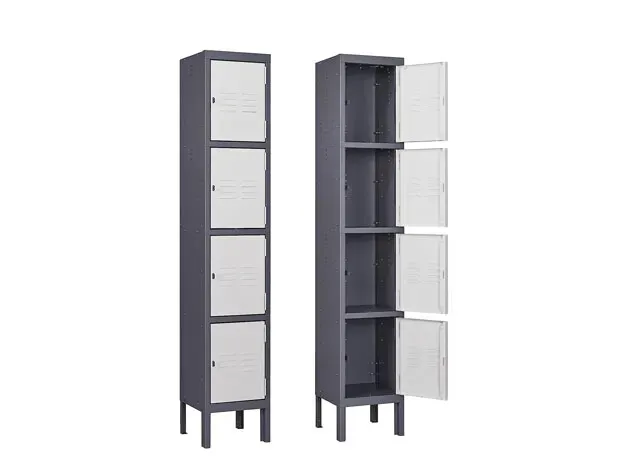Welcome to China Singdu Cabinets Manufacturer!
Steel lockers are a practical and secure storage solution used in a wide range of environments, including schools, offices, gyms, factories, and warehouses. Known for their strength, durability, and resistance to wear and tear, steel lockers help keep personal items organized and protected in both public and private spaces.
However, with so many types, sizes, locking mechanisms, and finishes available, choosing the right steel locker can be overwhelming. Factors such as intended use, available space, ventilation, security needs, and aesthetics all play a role in making an informed purchase.

When purchasing a steel locker, several factors are crucial to consider, including size, material, and security features.
The appropriate size depends on what you intend to store and the available space.
Determine What You'll Store:
Personal Items: For small items like phones, wallets, keys, and small bags, compact lockers (e.g., 12"W x 12"D x 12"H per compartment) are sufficient.
Clothing/Uniforms: Full-height lockers (e.g., 12"W x 18"D x 72"H or 15"W x 18"D x 72"H) with a coat rod and shelf are ideal for storing clothing, jackets, or uniforms.
Sports Equipment: Larger, wider, and deeper lockers (e.g., 18"W x 24"D x 72"H) may be needed for athletic gear, helmets, or specialized equipment.
Tools/Supplies: Consider the dimensions of your tools or supplies to ensure they fit comfortably. Industrial lockers often come in various configurations to accommodate different items.
Available Space:
Footprint: Measure the length and width of the area where the lockers will be placed.
Height: Account for ceiling height, especially if you're stacking lockers or if they are tall units.
Door Clearance: Ensure there's enough room for locker doors to open fully without obstruction.
Number of Users/Compartments:
Single-Tier: Provides one large compartment per user, ideal for full-length storage.
Multi-Tier (Double, Triple, Four, Five, Six-Tier): Offers multiple smaller compartments stacked vertically, maximizing space for a larger number of users with fewer items each.
Z-Lockers: A space-saving option that provides two compartments per unit while maintaining full-height hanging space in each.
Locker Bank Configuration: Lockers are often purchased in "starter" and "add-on" units. A starter unit is freestanding, while add-on units attach to a starter to form a continuous bank. Plan your layout accordingly.
Steel is a popular choice for lockers due to its durability and security. However, variations exist:
Gauge of Steel:
Higher Gauge Number = Thinner Steel: For example, 24-gauge steel is thinner than 16-gauge steel.
Common Gauges:
24-22 Gauge: Often used for basic, light-duty lockers in low-traffic areas (e.g., employee break rooms). Offers good value for general storage.
20-18 Gauge: A common choice for schools, gyms, and commercial settings. Provides a good balance of durability and cost.
16-14 Gauge: Heavy-duty, industrial-grade steel. Ideal for demanding environments, public areas, or when maximum security and resistance to denting are required.
Type of Steel:
Cold Rolled Steel: The most common type, offering a smooth finish and good strength.
Galvanized Steel: Steel coated with a layer of zinc for enhanced corrosion resistance. Excellent for humid environments or areas prone to moisture (e.g., pool changing rooms, outdoor applications).
Stainless Steel: Offers superior corrosion resistance and a sleek appearance. More expensive but ideal for hygiene-sensitive environments (e.g., food processing, medical facilities) or outdoor use where aesthetics and longevity are paramount.
Powder Coating/Finish:
Most steel lockers are powder-coated. This electrostatic application of dry powder paint cured under heat provides a durable, chip-resistant, and aesthetically pleasing finish.
Consider the color options to match your decor or branding.
Anti-microbial coatings are also available for environments where hygiene is critical.

The primary purpose of a locker is security. Evaluate these features carefully:
Locking Mechanisms:
Padlock Hasp: The most common option, allowing users to supply their own padlock. Flexible and cost-effective.
Built-in Key Locks: Each locker has its own key. Requires key management.
Built-in Combination Locks: Users set a combination. No keys to lose, but combinations need to be managed. Some have master key overrides.
Digital/Electronic Locks: Keypad entry with user-programmable codes. Often have master codes, audit trails, and can be set for permanent or temporary use (e.g., for day-use lockers). Offer high security and convenience but are generally more expensive.
Coin Operated Locks: Common in public places like gyms or train stations, requiring a coin deposit for use.
Door Construction:
Reinforced Doors: Doors with a double-pan construction or additional internal reinforcement are more resistant to prying and forced entry.
Continuous Hinges (Piano Hinges): Run the entire length of the door, providing greater strength and resistance to tampering compared to standard butt hinges.
Anti-Pry Latching Mechanisms: Features like multi-point latching or gravity-lift latches make it harder to pry open the door.
Ventilation:
Louvers: Slits on the top and bottom of the door or side panels to allow air circulation, preventing musty odors and humidity buildup, especially important for damp items (e.g., gym clothes).
Perforated Doors: Doors with a pattern of small holes offer maximum ventilation and allow for easy visual inspection of contents, but offer slightly less privacy.
Anchoring Options:
For added stability and security, especially in public areas or earthquake-prone regions, consider lockers that can be anchored to the floor or wall. This prevents tipping and makes it harder to remove the entire locker unit.
Number Plates/Tag Holders:
Allow for easy identification and organization of lockers.
Assembly:
Knock-Down (KD): Lockers shipped unassembled, requiring on-site assembly. More cost-effective for shipping but requires labor.
Assembled: Lockers arrive fully assembled. More expensive for shipping but ready to use immediately.
Accessories:
Sloping Tops: Prevents items from being stored on top of lockers, which can be untidy or a fire hazard. Also makes cleaning easier.
Closed Bases/Recessed Bases: Creates a cleaner look and prevents items from rolling under the lockers.
Legs: Elevates lockers off the floor for easier cleaning underneath.
Bench Seating: Integrated or freestanding benches for changing areas.
Number Plates/Tags: For locker identification.
Warranty and Reputation: Choose reputable manufacturers or suppliers that offer good warranties and have a track record of quality products.
Budget: Steel lockers come in a wide range of prices. Balance your needs with your budget, remembering that investing in higher quality can lead to greater longevity and security.
By carefully evaluating these factors, you can select steel lockers that meet your specific requirements for size, material durability, and security, ensuring a long-lasting and effective storage solution.
Share this page

Jun He Yun Gu Luoyang info&tech port #21-Unit 1-2nd floor-202, Lantai Road No.227, Y
Phone: 86-18739076120
E-mail: mike@singducabinet.com